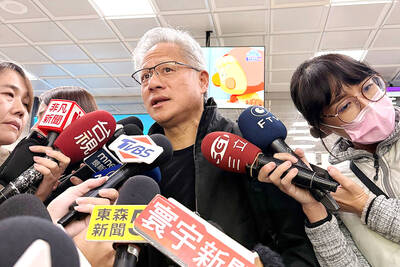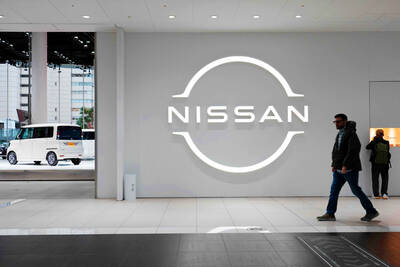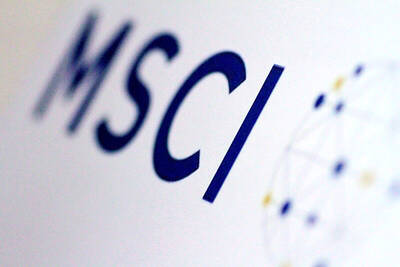US and European start-ups are racing to develop new batteries using two abundant, cheap materials — sodium and sulfur — that could reduce China’s battery dominance, ease looming supply bottlenecks and lead to mass-market electric vehicles (EVs).
Today’s EVs run on lithium-ion batteries — mostly made with lithium, cobalt, manganese and high-grade nickel, whose prices have soared. Western producers are struggling to catch up with their Asian rivals, and automakers expect supply bottlenecks to hit vehicle production at around the middle of the decade.
The EVs of the future — those arriving after 2025 — could shift to sodium-ion or lithium-sulfur battery cells that could be up to two-thirds cheaper than today’s lithium-ion cells.

Photo: AFP
Yet their promise hinges on potential breakthroughs in electrochemistry by start-ups such as Berlin-based Theion GmbH and UK-based Faradion, as well as Lyten in the US.
Newer battery chemistries have problems to be overcome. Sodium-ion batteries do not yet store enough energy, while sulfur cells tend to corrode quickly and do not last long.
Still, more than a dozen start-ups have attracted millions of US dollars in investment, as well as government grants, to develop new kinds of batteries.
For now, China dominates battery production, including the mining and refining of raw materials.
Benchmark Mineral Intelligence, a UK-based consultancy, estimates that China has 75 percent of the world’s cobalt refining capacity and 59 percent of its lithium processing capacity.
“We’re still dependent on a material supply chain from China,” said James Quinn, chief executive of sodium-ion battery start-up Faradion, which received more than US$1 million in government grants from Innovate UK before it was bought by Indian conglomerate Reliance Industries Ltd last year for US$117 million.
“If you look at the global geopolitical implications of that, it’s a challenge for energy security, economic security and national security,” Quinn said.
Asian battery giants are also working on new chemistries. China’s Contemporary Amperex Technology Co Ltd (新能源科技) has said it plans to begin producing sodium-ion cells next year. Korea’s LG Energy Solution aims to start making lithium-sulfur cells by 2025.
INSIDE THE BATTERY
The single most expensive element of an EV battery is the cathode, which accounts for up to one-third of the cost of a battery cell.
Most EV batteries today use one of two types of cathodes: Nickel cobalt manganese (NCM) or lithium iron phosphate (LFP). NCM cathodes are capable of storing more energy, but use costly materials (nickel and cobalt). LFP cathodes typically do not hold as much energy, but they are safer and tend to be less expensive, because they use materials that are more abundant.
The cost of key cathode materials such as nickel and cobalt has skyrocketed over the past two years.
That is why so many companies are hoping to substitute cheaper, more abundant materials such as sodium and sulfur, if their technical limitations can be overcome.
“Sodium ion definitely has a place, especially for stationary storage and low-end vehicles in cost-sensitive markets such as China, India, Africa and South America,” said consultant Prabhakar Patil, a former LG Chem Ltd executive.
“The introduction cost for lithium sulfur is likely to be higher — even though it has the potential to be the lowest cost — making consumer electronics the initial application,” Patil said.
Michigan-based Amandarry and British start-up AMTE Power are developing sodium-ion batteries using sodium chloride — basically table salt — as the main cathode ingredient. They do not need lithium, cobalt or nickel — the three most expensive battery ingredients.
Jeff Pratt, managing director of the UK Battery Industrialisation Centre — a state-funded £130 million (US$154.6 million) factory that rents out its production lines to start-ups to test battery chemistries — said he is trying to fit a sodium-ion start-up’s cells into a packed production schedule because it is “strategically important” to the UK’s hopes of being at the forefront of developing new, better batteries.
US firms Lyten and Conamix INc, Germany’s Theion and Norway’s Morrow Batteries ASA are developing lithium-sulfur cathodes that still need lithium in smaller quantities, but not nickel or cobalt.
By using ubiquitous cathode materials — sulfur is widely used in fertilizer, so is cheap like salt — these start-ups say that battery costs could be slashed by up to two-thirds, potentially making EVs affordable beyond the middle class.
Current EV battery packs typically range in cost from US$10,000 to US$12,000.
“If we can hit the targets we’ve identified with some of the world’s largest automakers, then we’re off to the races,” Conamix chief executive Charlotte Hamilton said.
ON THE ROAD
The battery start-ups say they are talking to major automakers, some of whom are testing new batteries that could be on the road in mass-market EVs before the end of the decade. The car companies are keen to keep their options open.
“Over time, more [battery] chemistries will come out,” said Linda Zhang, chief engineer on Ford’s F150 Lightning electric pickup truck. “It would be silly not to take advantage of those chemistries.”
At Tesla’s 2020 Battery Day, CEO Elon Musk said a “three-tiered approach” to lithium-ion batteries using different materials would be needed to build “truly affordable” EVs — mainly with iron-based LFP battery cells — as well as larger, more powerful and expensive EVs using nickel-based NCM or NCA cells with cobalt or aluminum cathode material.
Battery developers hope they can add sodium ion and lithium sulfur batteries to the range open to the auto industry.
Duncan Williams, managing director of advisory Nomura Greentech, said recent discoveries are closing the gap on issues like energy density and cycle life, “so we would expect to see both of these alternatives taking market share in the future.”
Michigan-based Amandarry is already producing sodium-ion cells at its plant in Haining, China, so those cells would not qualify for incentives under the US Inflation Reduction Act.
The company said it also plans to build a plant in North America.
Amandarry partner Amy Chen said the company’s first transportation application would likely be electric two-wheelers.
Aside from a cost advantage, Chen said that Amandarry’s batteries can charge really fast — 80 percent in 15 minutes.
AMTE Power chief executive Kevin Brundish said the company is initially launching with batteries for stationary energy storage systems, such as those used by grid operators, where energy density is less important.
Quinn said Faradion’s batteries are also already competitive with LFP cells and it has formed a joint venture for energy storage with agribusiness giant ICM Australia Pty Ltd.
At a relatively low scale, Faradion’s batteries should be one-third less expensive than iron-based LFP batteries, Quinn said.
He said that Faradion has had discussions with “most every major automotive company.”
“Within the next three to five years, you’ll see [our batteries] on the road,” he added.
‘WICKED HARD’
Sulfur is a “wicked hard chemistry” to make work in batteries, said Celina Mikolajczak, chief battery technical officer at California-based start-up Lyten, which has attracted US$47.5 million from investors, according to investment Web site PitchBook.
However, she said it is “the chemistry of the future, the chemistry that makes batteries mass market.”
Ulrich Ehmes, chief executive of Theion — ancient Greek for sulfur — said the problem with sulfur is that it is so corrosive that it kills a battery after 30 charges, but the Berlin-based company, which is backed by a handful of angel and private investors, has developed a way to treat and coat a lithium-sulfur electrode that should make it last an EV’s lifetime.
Theion expects to begin supplying batteries later this year to power pumps in commercial rockets during launch.
The company plans to begin sending test cells to vehicle manufacturers in 2024, with the first production EV applications expected around 2027, Ehmes said.
Theion believes its lithium-sulfur cathodes could store three times more energy than standard NCM cells, charge ultra fast and cut battery cell costs by two-thirds, to about US$34 per kilowatt-hour.
“It’s cheap, it’s high energy density so it seems to be a no-brainer,” Ehmes said.
Tony Harper, director of the Faraday Battery Challenge, the British government’s program that invests in fostering new battery technologies, said the automotive industry is increasingly worried about supplies of lithium, cobalt, manganese and nickel, so new chemistries are vital.
“This will take up the strain of what we thought would be a very, very difficult situation,” he said.

PERSISTENT RUMORS: Nvidia’s CEO said the firm is not in talks to sell AI chips to China, but he would welcome a change in US policy barring the activity Nvidia Corp CEO Jensen Huang (黃仁勳) said his company is not in discussions to sell its Blackwell artificial intelligence (AI) chips to Chinese firms, waving off speculation it is trying to engineer a return to the world’s largest semiconductor market. Huang, who arrived in Taiwan yesterday ahead of meetings with longtime partner Taiwan Semiconductor Manufacturing Co (TSMC, 台積電), took the opportunity to clarify recent comments about the US-China AI race. The Nvidia head caused a stir in an interview this week with the Financial Times, in which he was quoted as saying “China will win” the AI race. Huang yesterday said

Nissan Motor Co has agreed to sell its global headquarters in Yokohama for ¥97 billion (US$630 million) to a group sponsored by Taiwanese autoparts maker Minth Group (敏實集團), as the struggling automaker seeks to shore up its financial position. The acquisition is led by a special purchase company managed by KJR Management Ltd, a Japanese real-estate unit of private equity giant KKR & Co, people familiar with the matter said. KJR said it would act as asset manager together with Mizuho Real Estate Management Co. Nissan is undergoing a broad cost-cutting campaign by eliminating jobs and shuttering plants as it grapples

The Chinese government has issued guidance requiring new data center projects that have received any state funds to only use domestically made artificial intelligence (AI) chips, two sources familiar with the matter told Reuters. In recent weeks, Chinese regulatory authorities have ordered such data centers that are less than 30 percent complete to remove all installed foreign chips, or cancel plans to purchase them, while projects in a more advanced stage would be decided on a case-by-case basis, the sources said. The move could represent one of China’s most aggressive steps yet to eliminate foreign technology from its critical infrastructure amid a

MORE WEIGHT: The national weighting was raised in one index while holding steady in two others, while several companies rose or fell in prominence MSCI Inc, a global index provider, has raised Taiwan’s weighting in one of its major indices and left the country’s weighting unchanged in two other indices after a regular index review. In a statement released on Thursday, MSCI said it has upgraded Taiwan’s weighting in the MSCI All-Country World Index by 0.02 percentage points to 2.25 percent, while maintaining the weighting in the MSCI Emerging Markets Index, the most closely watched by foreign institutional investors, at 20.46 percent. Additionally, the index provider has left Taiwan’s weighting in the MSCI All-Country Asia ex-Japan Index unchanged at 23.15 percent. The latest index adjustments are to